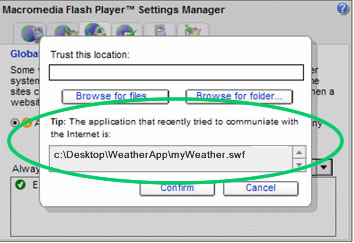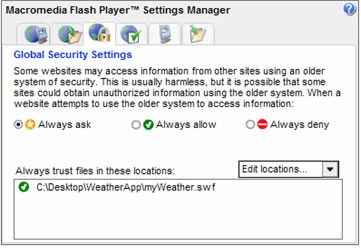How do I let local Flash content communicate with the Internet?
How do I let local Flash content communicate with the Internet?
Macromedia’s goal is to put users in control of their own data and computers. In Macromedia Flash Player 8 and later, certain types of local content are restricted from accessing data on your computer and sending it to the Internet without your knowledge or consent. The Flash Player Settings Manager can be used to allow content that you trust to communicate with the Internet. This TechNote explains how to trust your local content with the Settings Manager.
Why is my local content being blocked?
Flash Player security for local content restricts network communication for certain kinds of content that is stored on your local computer, unless you give permission. This security measure protects you from potentially harmful content that could be used to send sensitive information stored on your computer or local network to locations on the Internet.
This security measure occasionally prevents Flash content that you currently use and know to be safe from working correctly. You can fix this content by designating the content as trusted. Content that Flash Player is instructed to trust may access your computer and communicate with the Internet.
Note: Be sure that you trust the content you are trying to view before designating it as trusted.
Allowing local content to communicate with the Internet
You might have encountered a Flash Player Security warning dialog box (Figure 1) that notifies you that an untrusted application is trying to communicate with the Internet and has been blocked by Flash Player. If you recognize the application and want to allow it to access the Internet, you can use the Flash Player Settings Manager to add the content to your list of trusted content so that it can communicate with the Internet.
When you see the Flash Player Security warning dialog box:
- Click Settings (Figure 1) to go to the Global Security Panel of the Settings Manager. Clicking OK dismisses the dialog box, but the content will still be blocked by the Flash Player.

Figure 1. The Local File Security warning may appear when local content attempts to contact the Internet - Click Edit Locations (Figure 2) to access the pop-up menu, then select Add Location. A dialog box opens so you can add your content to the list of trusted files and locations.

Figure 2. The Global Security panel of the Settings Manager - To add the file or directory on your local computer, enter the location of the content in the Trust This Location box. If you accessed the Global Security dialog box from the Settings button in the security dialog box, you might see a hint showing you the location of that content on your computer (Figure 3). You can copy and paste the location into the text box, then click Confirm to add the location to the list of trusted locations.
You can also click Browse for Files or Browse for Folder to open a file chooser to navigate to the file or folder that you want to add to your trust list. Once you have made your selection, click Confirm to accept the location.
Note: Trusting a directory also trusts its subdirectories and any content within.

Figure 3. If you accessed the Global Security dialog from the Settings button in the security dialog, you should see a hint showing you the location of that content on your computer - The selected location should now appear in the list of trusted locations. You can now close the Settings Manager and return to the content or application. You will need to refresh the content in the browser, or restart the application, for the new settings to take effect. Flash Player should now allow the content to communicate with the Internet.

Figure 4. Your content should now appear in the list of trusted locations.
Why do I still see the local file security warning for content I have already trusted?
If you followed the steps above and still see the Flash Player Security warning for a particular piece of content that you have already trusted:
- You might need to add a few more files to the trusted list. Some applications are composed of multiple pieces (like SWF files and HTML pages). Each piece that attempts to communicate with the Internet must be designated as trusted. Consider trusting the entire directory which contains the content or application. For example, if the file that is trying to communicate with the internet is located at C:/SampleApp/sampleApp.swf, you can try adding the directory C:/SampleApp to trust all files in that directory. However, add an entire directory to the trusted list only if you trust all the content in the directory and its subdirectories. Never trust a top-level directory, such as C:/.
- The path you added to the trust list is mistyped or incorrect. You can check that the path you added is correctly pointing to the content by typing it directly in the browser address bar and verifying that the content is in that location.
- The content was moved after you added it to the trust list. If the content was moved after adding it to the list of trusted locations, the path registered with Flash Player will no longer point to the correct location. Follow the steps in this Service Note to add the new location. It is recommended you also remove the old location to avoid inadvertently trusting additional content.


Comments